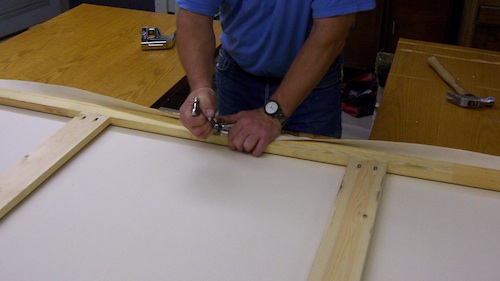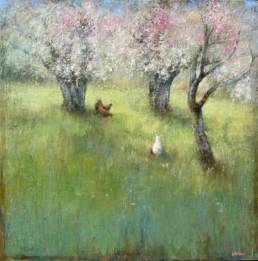As artists, we know that a trip to the art supply store can be expensive. Shopping for one item can quickly lead to a full cart, and it’s exactly these careless habits that can become dangerous, especially for artists trying to watch their budget or turn a profit.
Ideally, established artists making regular sales should be able to purchase the finest supplies. But in today’s economy, it’s smart for everyone to be budget conscious.
The good news is, this does not mean you’ll have to skimp on quality or go without a supply you need just because you can’t afford it. Happily, artists of all abilities and tax brackets can find awesome deals on great art supplies — it just takes a little time, research and careful shopping.
That’s where we come in! We have done the research for you by gathering up the 10 easiest ways to save money on art supplies…
1. Be a repeat buyer:
If you’re a frequent customer of the same art supply store, ask if they offer a discount for repeat buyers. Usually this discount comes in the form of store credit and is a great deal if you know you’ll be back.
If your go-to art store doesn’t offer such deals, it may be smart to look for one in your area that does — but only if it offers what you need and is within your price range. There’s no sense in driving farther, paying more or being disappointed with your purchase just because you have store credit to spend.
2. Don’t over do it on paint:
Not using as much paint is a great way to keep costs down and avoid unnecessary waste. When portioning out your paint colors, be mindful of how much you’re using, as well as its intended use. Mix colors as you go and try to reuse or use up the paint you’ve mixed for previous works.

Another great way to save on paint is to buy tubes of glazes rather than impasto. Glazes are thinner and can be easily stretched. If your artwork requires more texture, don’t be afraid to use texture paste or get creative with collage. Fibrous paper or old newspaper scraps can be a great way to build up the body of your work. Student acrylic paint is also a great option for artists who desire a certain effect, but don’t want to break the bank.
3. Coupons:
To save money on everything from paint thinner to fiber-tip pens, cut and download coupons offered by major art supply chains or craft stores. Often times these stores offer great easy to find deals. Just type in the name of the store and “coupon” in any search engine and you’ll be amazed by the results. For even better results, sign up for the store’s email newsletter. They’ll send you their latest deals and coupons unavailable to the general public.
Of course, old-fashioned techniques are also still an effective way to save cash. Check out the major newspapers in your area for big brand coupon ads too.
4. Stretch Your Own Canvas:
There’s no way around it — pre-stretched and primed canvases are expensive, and this can present an interesting problem for fine artists who don’t want to blow their previous commission on a new canvas. However, since most artists agree that canvas is the perfect medium, stretching your own canvas can be a really fantastic way to save money and allow for more experimentation as an artist. By stretching your own, you’ll have more surfaces to play with, and you won’t be hoarding expensive canvas for only the “good paintings.” To get started, check out this ArtBistro tutorial, or peruse the web for helpful video tutorials.

Another helpful money saving idea is to reuse old canvases. Too many artists throw away old works they no longer like or aren’t selling. This is wasteful, especially since a canvas can easily be reused by flipping it over or priming it with gesso. An alternative way to save money on canvas is to not use it at all. Experiment with painting on wood, glass or even properly prepared paper. Most artists find that anything primed with gesso becomes a sufficiently paintable surface.
5. Buy in bulk:
Artists who properly care for their supplies can keep their wares for years. If you have the space and know you will definitely use the product, it’s a good idea to buy a lot of it at a decent bulk price, especially since that means a higher profit for you when it comes time to sell your piece. However, don’t buy it if you’re not sure you’ll use it or have never tried it! Too many artists go crazy over a good deal and forget to be practical. This leads to a lot of waste, both in product and in studio space.
6. Keep your existing supplies in good condition:
Well-kept art supplies can last for years.
- For example, a good set of paintbrushes or pallet knives can last a lifetime.
- Unfortunately, many artists don’t properly maintain their supplies and this frivolity leads to the loss of hard-earned money.
- Carefully clean all utensils with soap and water or turpentine (for oils only) after each use.
- Always shake water out of the brushes and pat dry with a towel in the direction of the bristles.
Double-check that paint lids are on properly and stored at mild temperatures. And, never mix paintbrushes! If you’ve used it with oil-based paints, it’s only an oil-based paintbrush. This goes for water-based paintbrushes too.

It’s also a good idea to keep your studio neat and clean since it’s where the majority of your art supplies are stored. A clean space enables your supplies to be properly organized, accessible and easy to put away once you’re finished. Keep your workspace neat by laying down old sheets or plastic tablecloths and have multiple trashcans on hand.
7. Buy online:
Shopping at online art stores means you’ll save a bundle, even in your pajamas. Smaller art supply stores have a tendency to charge more due to less customer volume, so buying through bigger stores is a smart idea. Bigger brands also have a larger selection of online supplies and an easily accessible sale section.
Another great way to buy online is through private sellers. Utilize free online classified advertisements and auctions to buy the items you need. This method can also be a great way for artists to make money off old or outdated supplies. Turn your investments into cash by selling them online, then put that money into a newer tool.
8. Don’t discredit garage sales:
Like we mentioned before, canvases of any size can come with hefty price tags. Unfortunately, so can wooden easels or even high-quality pastels or pencils. Garage, estate or moving sales offer a great way to find great deals, and unlike online stores, allow buyers to thoroughly check out the merchandise before purchasing.
- For example: mass produced prints can be easily primed to make super-cheap blank canvases and a few extra screws or wood glue can repair an old easel. With creative spending and a little elbow grease, you can save between $50-100 dollars on most supplies!
Just remember, stick to what you need. Don’t bring home a bunch of garage sale clutter just because it was a good price. And if you have trouble estimating an item’s worth or struggle with indecisiveness, bring a friend.
9. Evaluate what you actually need:
Being a profitable artist means deciphering between the supplies you need, the supplies you want and the supplies others may need but you can do without. For instance, if you paint better with your canvas lying flat on a table, don’t buy an expensive easel that will never get used. Counter tops and tables are usually an ideal height and are perfectly suitable surfaces to paint on.
- Your artist palette is another piece of equipment that’s easy to forgo. Try using clean, dry Styrofoam plates from the butcher or produce stand. These surfaces are nice and flat, as well as easily washable. Plus, you’re doing the environment a favor by reusing a material that can’t be recycled.
10. Splurge once in a while:
No artist, or person for that matter, can be budget conscious always. There are just some supplies and tools you need no matter the cost. Items like this should be purchased occasionally and with much deliberation. That being said, sometimes it’s best to buy quality materials, but in smaller quantities. Start small and steadily build your supply. Keeping your supplies simple and valuable is a great strategy for creating strong artworks and solid bank accounts.
*****
PS. Let’s meet on Facebook and Twitter! ~Lori (or if you want to see my paintings)
Be sure and take a look at these other interesting articles:
10 Reasons Why You Should Date an Artist
Creating an Earth-Friendly & Healthy Art Studio
Artistic Temperament: What to Do When it Strikes!
Top Paint Brush Tips from the Art Pros on Facebook
Go ‘Green Clean’ – Purify the Air in Your Studio or Office with House Plants!
How to Choose the Right Paint Brush for the Art Technique
Water Soluble Oils: Facts, Tips & Why I Use Them
A Study in Complimentary Colors using Yin Yang










I would like to learn how to stretch my own canvases. Is there a link missing because I could not find the ArtBistro link to stretching canvases. Thx
Great list of budgeting reminders. Thank you Lori!
Hi Carol,
I build my own frames and stretch canvases. At first very time-consuming but I got faster and better after a while. Every two weeks, I build new ones, so I always have some ready. I just wrote something about how to build the frames (http://www.flavordesigns.com/2011/02/how-to-custom-build-your-own-frames/) with pictures and when I make new ones will post something about canvas stretching.
@Lori: I just decided to use pigments and mix my own oil paint, I had no idea how much cheaper that is and how easy! Found a website that sells non-toxic pigments -they have recipes for all kinds of paint projects from household to artist’s paint, more on my blog!
Awesome suggestions, thank you
Franziska San Pedro
The Abstract Impressionist Artress
Hola Señora San Pedro,
I hope you are still checking your entry on this page of Madame McNee,because I think you can help me really good by answering this following question for me:
I am an artist too, but I moved to another location, so now, I do not have my old long time well known art supplies store at the corner anymore. I want to know if You are informed about any online possibilities to “buy online” canvas/linen roll for a good saving prize? I will do the framing, just the linen roll i need. I thank You very much in advance and hope to receive an answer from you soon.
Best regards,
Eduardo
Hello Eduardo,
Thank you for your patience with me. I am behind on my comment replies. Yes, there are many online stores where you can buy canvas or linen. Here are some links. I hope this helps you…
Lori
https://www.google.com/url?sa=t&rct=j&q=&esrc=s&source=web&cd=1&ved=0CIMBEBYwAA&url=http%3A%2F%2Fwww.utrechtart.com%2FUnstretched-Canvas-Canvas.utrecht&ei=VqeVT6jcHe-r2AX3t4WLBQ&usg=AFQjCNGBprw5vkYgElb4wq3LJCTFr9ESrQ&sig2=wM3c_vLhAsJgKtc8zkgz6A
http://www.google.com/aclk?sa=l&ai=C7dMoVqeVT-juIojGsQLg5f3zBvqugD6ynIq2MeOl0Z8MCAAQASgDUO3diMv6_____wFgyabzh-yj5BegAfG_wf8DyAEBqgQfT9CpmXZG1S0UJuJDy2bwTmmVnD81TDmm7fzJvjobEg&sig=AOD64_32btqp2qJ1NasQHUBNNdDnNW4Jug&ved=0CBEQ0Qw&adurl=http://www.dickblick.com/categories/canvas/%3Fwmcp%3Dgoogle%26wmckw%3Dlinen%2520canvas%2520roll%26wmcid%3Dadwords%26cid%3Dpsgbr08041178&rct=j&q=canvas+linen+roll
https://www.google.com/url?sa=t&rct=j&q=&esrc=s&source=web&cd=5&ved=0CJYBEBYwBA&url=http%3A%2F%2Fwww.cheapjoes.com%2Fcat%2F4850%2F&ei=VqeVT6jcHe-r2AX3t4WLBQ&usg=AFQjCNEpkSu8FNA4d6cBsNIE-_blnvh5Jg&sig2=BwXZSAU2Z00m0dDkxUJUzw
https://www.google.com/url?sa=t&rct=j&q=&esrc=s&source=web&cd=8&ved=0CKsBEBYwBw&url=http%3A%2F%2Fwww.aswexpress.com%2Fdiscount-art-supplies%2Fcanvas-and-boards%2Frolls.html&ei=VqeVT6jcHe-r2AX3t4WLBQ&usg=AFQjCNGyHIY2hN0Fl7_9XcnIsHN9f_ynHw&sig2=LFqbi5JHF0JyZo4Kv6__6w
When I switched to painting with a knife, I was astounded as to how much I saved on not buying brushes… (I didn’t switch for this reason, but it sure reinforces the method later)…
Plein Air philosophy… Not being obsessed with having a studio- it is a state of mind… I joined a Plein Air artists group, & the main benefit has been to let go of the idea that I have to have a studio… I used to pay 500 dollars a month for a studio… Painting outside has improved my work & lightened my budget burden…
Buy locally made paints… I switched from Schmincke Mussini oils made in Germany to Kama Pigments walnut oils made in Montreal… Cost is like 1/3 less… (again, I didn’t switch for the money- more because my works were looking too “German” for some reason)…Buying locally also thrills your local worker…
Take longer for each work…
One note of caution: While stretching your own canvases may seem cheaper initially- if you are like me & screw things up endlessly, it can end up costing much more… I got fancy this time, & tried to hand stretch with tacks & a hammer, linen, & ended up with a droopy canvas later when the painting was halfway through… Then I had to add metal expanding corner brackets to push apart the bars to tighten everything up, & also had to fix the painting itself due to the sag… Then I added wood corner keys to further tighten it all… I was using 2 &1/4 inch thick bars, which turned out to be quite heavy, & now I look back & think fondly of that pre-stretched linen… (Though I learned alot & have bigger muscles in my arms now)…
Hello Sari and thanks for the great comment. What a wonderful thought you shared here – a plein air studio! That is great. Also, thanks for adding your canvas stretching experience here. I agree with you…I’d rather be spending my time painting rather than stretching canvases. Thanks again for the visit and comment!
Happy painting-
Lori
Great tips! I’m a photographer and wanted to start doing gallery wraps, but it’s too expensive to have it done. I just did my first last week – I printed my photo on Fredrix inkjet canvas and then stretched it myself. Following another of your tips, I ordered several pre-assembled stretcher bars online, at a better price than buying the bars individually at the store near me. Any other photographers doing their own gallery wraps?
Heidi
Youentioned garage sales but I also get a lot of cheap art supplies from thrift stores as well! I’m amazed at what I can find. I have a lot of supplies as I get bored of an idea after a month lol..but the semi hoarded stuff does come in later handy often.
Hi Abbi, that is a great tip! Thanks for suggesting thrift stores. 🙂